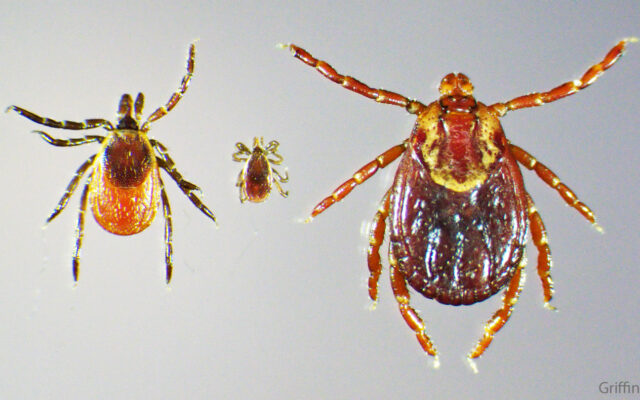
The 5 disease-carrying ticks you can find in Maine
By Julia Bayly, Bangor Daily News Staff
As tick populations increase across Maine, tick-borne diseases have become a public health issue in the state. Of the 15 species of ticks found in Maine, five of them pose very serious health threats to people.
The five disease-carrying ticks in Maine are the deer tick, the dog tick, the squirrel tick, the woodchuck tick and the lone star tick.
The risk of contracting a tick-borne disease varies with the season and your location. Tick and health experts urge anyone who spends time outdoors to conduct thorough whole-body tick checks after coming inside. Pets and livestock should also be checked for ticks on a regular basis.
Deer ticks
The carrier of the most diseases in Maine is the deer tick. These tiny ticks — some no larger than a sesame seed — can transmit Lyme disease, anaplasmosis, powassan and babesiosis as adults and as immature ticks commonly called nymphs. Lyme disease was first reported in Maine in 1986, and cases have been steadily increasing ever since, according to the University of Maine Cooperative Extension Tick Lab. The most recent data from the Maine Center for Disease Control and Prevention shows there were 2,079 cases or suspected cases of Lyme disease in Maine in 2018.
Common signs of Lyme disease include headache, fever, chills, joint and muscle pain, fatigue, and a characteristic expanding “bullseye” rash known as erythema migrans. Long-term complications from untreated infections can result in severe arthritis, facial palsies, meningitis and inflammation of the heart.
Cases of anaplasmosis have been increasing in Maine over the past eight years, doubling annually from 2012 to 2017, according to the UMaine Extension Tick Lab. Symptoms include fevers, chills, body aches, severe headaches, fatigue and gastrointestinal distress. Most cases are mild, but in some instances they result in encephalitis and meningitis and can be fatal.
Increasing more slowly in Maine are cases of babesiosis, which has many of the same symptoms as anaplasmosis but also include dark urine or jaundice.
Last month a Waldo County resident died after contracting powassan. This was only the third fatality associated with the deer tick-borne disease that causes infection to the brain. Symptoms include fever, headache, vomiting, weakness, confusion, loss of coordination, slurred speech and seizures.
Woodchuck ticks and squirrel ticks
Powussan is also carried by the woodchuck tick and the squirrel tick.
Dog ticks
Dog ticks, which saw a population explosion last summer, carry Rocky Mountain Spotted Fever and tularemia. Only the adult females carry these diseases.
Early signs of Rocky Mountain Spotted Fever, such as a fever and headache, can be mistaken for other illnesses. But the disease can progress rapidly to life threatening. Additional symptoms include a distinctive skin rash, nausea, muscle pain and loss of appetite.
Also called rabbit fever or deer fly fever, tularemia mainly impacts rabbits and rodents. It is rare in humans but can cause skin ulcers, swollen lymph glands, inflammation to the eyes, mouth sores, sore throat and pneumonia.
Lone star ticks
The lone star adult ticks and nymphs can transmit the Alpha-gal sugar molecule to humans. This molecule is found in red meat and in some people the molecule can trigger a reaction from their immune system creating an allergy to meat. These allergic reactions can take several hours to show up and include hives, swelling of the lips, face or throat, shortness of breath, gastrointestinal distress, sneezing, headaches and anaphylaxis.
Lone star ticks can also carry ehrlichiosis, which causes fevers and muscle aches.
Anyone showing symptoms of these tick-borne diseases and who has found a tick bite on their body or who has spent time in areas of tick habitat should talk with their medical provider.